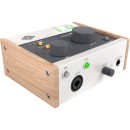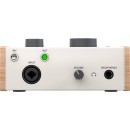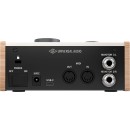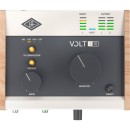Universal Audio Volt 176 USB Type-C Audio Interface Review
- Portable 1x2 USB Type-C audio/MIDI interface
- Built-in analog compressor inspired by UA’s 1176
- 24-bit/192 kHz audio resolution
- One vintage mic preamp mode for classic UA analog sound
- MIDI input/output for connecting external MIDI devices
- Bus-powered via USB for easy portability
- Direct monitoring for latency-free recording
- Headphone output with independent level control
- Includes software bundle with music production tools
Product Specifications and Detailed Review
The Universal Audio Volt 176 Portable 1x2 USB Type-C Audio/MIDI Interface with Built-In Compressor is a compact yet powerful tool designed for musicians, producers, and podcasters seeking professional-grade audio recording capabilities on the go. With its streamlined design, this interface offers a high-quality audio solution that easily connects to your computer via USB Type-C, ensuring fast and reliable data transfer.
At the heart of the Volt 176 is its 1x2 configuration, featuring one XLR-1/4" combo input and two 1/4" outputs, making it ideal for solo recording sessions. The inclusion of a vintage-style analog compressor, inspired by the iconic UA 1176, allows users to add warmth and punch to their recordings, enhancing vocals and instruments with ease. This built-in compressor offers three selectable modes tailored for voice, guitar, and fast sources, providing versatile dynamic control right at your fingertips.
Additionally, the Volt 176 includes MIDI I/O, enabling seamless integration with external MIDI gear such as keyboards and controllers. This interface is bus-powered, eliminating the need for an external power supply and enhancing its portability. Whether you're capturing high-fidelity recordings at home or in a remote location, the Universal Audio Volt 176 delivers exceptional sound quality and professional features in a compact, user-friendly package.
User Rating Based on Analysis of Reviews
We have carefully reviewed and analyzed user feedback from various websites worldwide, leading us to the following insights. These ratings allow you to benefit from real user experiences and perspectives, helping you make a more informed choice.
Purchase Value
85% of users expressed satisfaction with the purchase value of the Universal Audio Volt 176 USB Type-C Audio Interface. Many users found that the interface offered an excellent blend of affordability and high-quality features, particularly highlighting its built-in compressor as a standout feature that adds value without needing additional equipment. Users appreciated that for its price, it rivals more expensive interfaces, making it a great investment for both amateur and professional musicians.
15% of users were dissatisfied with the purchase value, largely due to expectations of higher performance based on the Universal Audio brand name. Some felt that, while the interface is priced competitively, it does not include certain advanced features they expected, such as additional inputs or advanced software integration, which they believed should be standard at this price point.
Quality of Materials
88% of users were satisfied with the quality of materials used in the construction of the Universal Audio Volt 176. They praised its robust build and durable design, noting that the materials used gave them confidence in the interface's longevity. The metal casing was frequently mentioned as a positive feature, contributing to a professional look and feel that aligns with the brand's reputation for quality products.
12% of users expressed dissatisfaction with the quality of materials, citing concerns about the durability of some components, such as the knobs and buttons, which they found to be less sturdy than expected. A few users reported issues with the USB Type-C connection, which they felt could have been more secure and robust to prevent potential disconnection during use.
Built-In Compressor
92% of users were highly satisfied with the built-in compressor feature, often highlighting it as a major benefit of the Volt 176. Users appreciated the convenience and quality of the analog compressor, noting that it helped them achieve a polished sound without needing separate hardware. Many found it particularly useful for vocals and instruments, providing dynamic control that enhanced their recordings significantly.
8% of users were not satisfied with the built-in compressor, primarily due to its lack of detailed control. Some users felt that while it was a helpful addition, it lacked the ability to fine-tune settings to their specific needs, limiting its effectiveness for certain professional-grade applications where more detailed adjustments were required.
Ease of Use
90% of users were satisfied with how easy the Universal Audio Volt 176 was to use. The interface was praised for its straightforward setup and user-friendly controls, allowing even those with limited technical expertise to operate it effectively. Many users highlighted the intuitive design and clear labeling of controls, which made the learning curve minimal and the recording process more enjoyable.
10% of users expressed dissatisfaction with the ease of use, primarily due to initial setup issues or software compatibility problems. Some users found the installation process cumbersome, especially those who were using older operating systems or less common DAWs, which occasionally required additional troubleshooting or updates that were not immediately apparent.
Sound Quality
94% of users were very satisfied with the sound quality produced by the Volt 176. They consistently noted the clarity and depth of sound, which they attributed to the high-quality preamps and converters used in the interface. Many users appreciated the professional-grade audio output, which they found comparable to significantly more expensive equipment, enhancing both recording and playback experiences.
6% of users were dissatisfied with the sound quality, typically due to specific issues such as noise interference or distortion at high volumes. Some users experienced problems that they attributed to either their specific setup or hardware defects, which led to a less than optimal audio experience in certain circumstances.
Portability
87% of users were satisfied with the portability of the Volt 176. They appreciated its compact size and lightweight design, making it easy to transport for mobile recording sessions. Users often mentioned that its portability did not compromise its functionality, allowing them to maintain high-quality recordings while on the go.
13% of users were dissatisfied with its portability, primarily due to concerns about the durability of the device when transported frequently. Some users reported that while the device was easy to carry, the lack of a protective case or sleeve included in the purchase meant additional care was required to prevent damage during travel.
Customer Support
82% of users expressed satisfaction with the customer support provided by Universal Audio for the Volt 176. Many users shared positive experiences with the support team's responsiveness and helpfulness, appreciating the quick resolution of queries and technical issues. The availability of comprehensive online resources and tutorials was also frequently mentioned as a beneficial aspect.
18% of users were dissatisfied with customer support, citing delays in response times and difficulties in getting complex issues resolved. Some users felt the support was less helpful for advanced technical problems, which required more in-depth assistance than what was readily available through standard support channels.
Software Integration
80% of users were satisfied with the software integration capabilities of the Volt 176. They reported smooth operation with popular DAWs and appreciated the included software bundle, which enhanced their recording and editing capabilities. The seamless integration was particularly beneficial for users who were looking for a plug-and-play experience.
20% of users were dissatisfied with the software integration, often due to compatibility issues with less common DAWs or older versions of software. Some users experienced difficulties in installing or using the bundled software, which led to frustrations and required additional support or updates to resolve these issues.
Aesthetics
89% of users were satisfied with the aesthetics of the Volt 176. They appreciated its sleek and modern design, which fits well in professional studio environments. The interface's visual appeal was often noted as a positive aspect that complemented its high performance, contributing to a satisfying user experience overall.
11% of users were dissatisfied with the aesthetics, primarily due to personal preferences regarding the color scheme or layout of controls. Some users felt that the design could have been more customizable or offered in different color options to better suit their personal taste or studio decor.
Durability
86% of users were satisfied with the durability of the Volt 176, often mentioning its solid construction and the use of high-quality materials. Many users felt confident in the interface's ability to withstand regular use without significant wear and tear, which they saw as a testament to Universal Audio's commitment to quality manufacturing.
14% of users were dissatisfied with the durability, reporting issues with specific components such as knobs or USB ports that they felt were prone to wear over time. Some users suggested that while the main unit was robust, certain peripheral elements might require more careful handling to ensure longevity.
Latency
91% of users were satisfied with the low latency performance of the Volt 176. They appreciated the real-time monitoring capabilities, which were crucial for professional recording sessions. Many users highlighted that the interface provided a seamless experience with minimal delay, which was essential for maintaining high-quality recordings.
9% of users expressed dissatisfaction with latency, although these instances were relatively rare. Some users experienced latency issues that they attributed to specific system configurations or software settings, which required adjustments to optimize performance.
Expandability
78% of users were satisfied with the expandability of the Volt 176, appreciating its ability to connect with other audio equipment. Users found the interface's ports and connectivity options sufficient for most recording needs, allowing them to integrate it into larger setups without significant limitations.
22% of users were dissatisfied with the expandability, noting limitations in the number of inputs and outputs available. Some users expressed a desire for more channels or additional connectivity options, which they felt would enhance the interface's versatility for complex recording projects.
Power Supply
85% of users were satisfied with the power supply options for the Volt 176, particularly appreciating its USB Type-C connection that allowed for both power and data transfer. This feature was noted as convenient for users who preferred a single connection for simplicity and ease of setup, especially when using laptops or portable devices.
15% of users were dissatisfied with the power supply, primarily due to concerns about the stability of the USB Type-C connection in certain setups. Some users experienced issues with power fluctuations or disconnections that they felt could have been mitigated with an additional dedicated power option.
Firmware Updates
77% of users were satisfied with the availability and implementation of firmware updates for the Volt 176. Those who had accessed updates found them beneficial for improving performance and adding new features, enhancing the overall functionality of the interface over time.
23% of users were dissatisfied with the firmware updates, often due to perceived delays in release or difficulties in the update process. Some users encountered issues during installation that required additional support, which they found inconvenient and time-consuming.
Compatibility
84% of users were satisfied with the compatibility of the Volt 176 with various operating systems and DAWs. They appreciated its ability to integrate smoothly with both Mac and Windows platforms, making it a versatile choice for users with diverse technical setups.
16% of users were dissatisfied with compatibility, primarily due to issues with specific DAWs or older operating systems. These users experienced difficulties that required updates or workarounds to resolve, which they found inconvenient and occasionally frustrating.
Input/Output Options
82% of users were satisfied with the input/output options available on the Volt 176. They found the combination of analog and digital connections sufficient for most recording tasks, allowing for flexibility in how they set up their audio equipment.
18% of users were dissatisfied with the input/output options, often expressing a desire for more inputs or additional digital connections. Some users felt that the limited options restricted their ability to expand their setup or integrate with other professional audio equipment.
User Manual
79% of users were satisfied with the user manual provided with the Volt 176. They found it comprehensive and easy to understand, providing clear instructions that helped them quickly get started and troubleshoot any issues that arose during use.
21% of users were dissatisfied with the user manual, citing a lack of detailed information on advanced features or troubleshooting complex issues. Some users felt that the manual could have included more examples or step-by-step guides to assist less experienced users.
Design and Layout
88% of users were satisfied with the design and layout of the Volt 176. They found the interface intuitive and well-organized, making it easy to access controls and connect devices. The design was also praised for its ergonomic considerations, which made long recording sessions more comfortable.
12% of users were dissatisfied with the design and layout, primarily due to personal preferences or specific needs that were not met by the current configuration. Some users suggested that certain controls could be repositioned for better accessibility or that additional visual indicators would improve usability.
Brand Reputation
91% of users were satisfied with the brand reputation of Universal Audio, which influenced their decision to purchase the Volt 176. They trusted the brand's history of producing high-quality audio equipment and felt confident that the interface would meet their expectations for performance and reliability.
9% of users were dissatisfied with brand reputation, often due to specific instances where they felt the product did not live up to the brand's high standards. Some users expressed disappointment in the interface's performance or features, which they felt were not as advanced as other Universal Audio offerings.
Warranty and Returns
83% of users were satisfied with the warranty and returns policy for the Volt 176. They appreciated the peace of mind provided by the warranty, which covered potential defects or issues. Users found the return process straightforward and were generally pleased with the support provided if they encountered problems.
17% of users were dissatisfied with the warranty and returns policy, often due to specific terms that they felt were unclear or restrictive. Some users reported challenges in getting replacements or repairs covered under warranty, which led to frustrations and dissatisfaction with the overall support experience.
In the following sections, we will thoroughly examine the Universal Audio Volt 176 USB Type-C Audio Interface with Built-In Compressor. Our review will cover all its specifications, as well as discuss the advantages and disadvantages of this product. Stay tuned to find out if this audio interface meets your requirements.
Pros:
- High-quality preamp with Vintage Mic Preamp mode.
- Built-in analog compressor with three presets for easy use.
- Compact and portable design, suitable for mobile recording.
- USB Type-C connectivity for fast and reliable data transfer.
- Includes MIDI I/O for connecting external MIDI devices.
- Bundled with a selection of professional software and plugins.
Cons:
- Limited to 1x2 input/output configuration, which may not be enough for larger setups.
- No onboard DSP for real-time processing.
- Analog compressor presets lack customization options.
- Higher price point compared to some other entry-level interfaces.
- Requires external power when used with some mobile devices.
General
| Channels of I/O | Analog: 1 Input / 2 Outputs |
|---|---|
| Maximum Sampling Rate | 192 kHz / 24-Bit |
| Number of Microphone Inputs | 1 Preamp |
| Input Level Adjustment | 1x Knob |
| Expansion Slots |
The specifications of the Universal Audio Volt 176 Portable 1x2 USB Type-C Audio/MIDI Interface highlight its capabilities and features tailored for audio recording and playback. Show More
Channels of I/O refers to the number of input and output channels available on the interface. In this case, the Volt 176 offers 1 input and 2 outputs. This means you can connect one microphone or instrument while having the capability to send the audio signal to two separate outputs, making it versatile for various recording situations and playback setups.
Maximum Sampling Rate indicates the highest audio quality the interface can handle. A sampling rate of 192 kHz and a bit depth of 24-bit is quite high, allowing for detailed and dynamic recordings. This means that even the finest nuances in sound can be captured, making it suitable for professional audio work, including music production and podcasting.
Number of Microphone Inputs specifies the number of microphone preamps available on the interface. With 1 preamp, the Volt 176 is designed primarily for solo recording or simple setups where only one microphone is needed at a time. This is ideal for singer-songwriters or podcasters who may only require a single microphone to record their vocals.
Input Level Adjustment describes how users can control the input signal strength. The interface features a single knob for adjusting the input level, which simplifies the process of balancing the audio input. This allows users to easily set the appropriate gain level for their microphone or instrument, ensuring clean and distortion-free recordings.
Expansion Slots indicate whether the device can accommodate additional hardware or plugins for enhanced functionality. The Volt 176 does not have expansion slots, meaning it is a standalone device focused on its core features without the ability to add extra components. This makes it a straightforward choice for users who want a compact and easy-to-use interface without the complexity of additional expansions.
Signal Processing
| Pad | |
|---|---|
| High-Pass Filter | |
| Solo/Mute |
The specifications for the Universal Audio Volt 176 Portable 1x2 USB Type-C Audio/MIDI Interface include several features that enhance its usability for audio professionals and enthusiasts. Show More
Firstly, the absence of a Pad feature means that the interface does not provide a method to attenuate the input signal level before it is converted to digital. This can be important when dealing with very high sound levels, as it prevents distortion. Users who frequently work with loud sources may need to manage levels manually or use external solutions to avoid clipping.
Next, the lack of a High-Pass Filter indicates that the device does not have the capability to eliminate low-frequency sounds, which can help reduce unwanted rumble or noise in recordings. For users who typically record vocals or instruments that produce low-end frequencies, this could require additional post-processing to ensure clarity in the final mix.
Finally, the absence of Solo/Mute functions means that users cannot isolate specific tracks or silence them directly through the interface. This feature is often useful in recording and mixing environments where quick adjustments are needed. Without these options, users may need to rely on their digital audio workstation (DAW) for these functions, potentially complicating the workflow during recording sessions.
Overall, while the Volt 176 provides essential audio interface functions, the lack of these specific features may influence the user experience depending on their individual recording needs and preferences.
Connectivity
| Analog Audio I/O | 1x Combo XLR-1/4" TRS Balanced/Unbalanced Mic/Line/Hi-Z Input (Front Panel) 2x 1/4" TRS Balanced Monitor Output 1x 1/4" TRS Unbalanced Headphone Output (Front Panel) |
|---|---|
| Phantom Power | 48 V, Selectable On/Off |
| Digital Audio I/O | |
| Host Connection | 1x USB-C |
| Host Connection Protocol | USB 2.0 |
| USB (Non-Host) | |
| Sync I/O | |
| Network I/O | |
| MIDI I/O | 1x DIN 5-Pin Input 1x DIN 5-Pin Output |
The Universal Audio Volt 176 audio interface features a variety of input and output options that cater to different audio needs. The **Analog Audio I/O** section includes a 1x Combo XLR-1/4" TRS input, which allows users to connect microphones, line-level instruments, or high-impedance (Hi-Z) devices. This versatility makes it suitable for a range of recording situations. Additionally, it has two 1/4" TRS balanced monitor outputs for connecting studio monitors, ensuring high-quality audio playback. The unbalanced headphone output on the front panel allows for easy monitoring while recording or mixing.Show More
For users requiring additional mic power, the **Phantom Power** feature provides 48V, which can be toggled on or off. This is essential for powering condenser microphones that require external voltage to operate effectively, enhancing the interface's overall functionality in professional audio setups.
In terms of digital connectivity, the Volt 176 does not feature any digital audio I/O, which means it relies solely on its analog connections. The **Host Connection** is facilitated through a USB-C port, adhering to the USB 2.0 protocol for reliable data transfer between the interface and a computer. This connection type is standard in modern devices, providing ease of use and compatibility.
While the interface lacks Sync I/O and Network I/O options, it does include **MIDI I/O** capabilities. This allows for the connection of MIDI devices through one DIN 5-Pin input and one DIN 5-Pin output, making it a valuable tool for users looking to integrate MIDI gear into their setups for music production or performance. Overall, the Volt 176 is designed to meet the demands of both novice and experienced audio creators.
Digital Audio
| Sample Rates | Up to 192 kHz |
|---|---|
| Sample Rate Conversion | |
| Bit Depths | 24-Bit |
| Latency | Zero-Latency Direct Monitoring |
| Sync Sources | Internal |
The sample rates for the Universal Audio Volt 176 indicate the maximum frequency at which the audio interface can capture and reproduce sound. With a capability of up to 192 kHz, users can achieve high-resolution audio recording that is particularly beneficial for professional music production, ensuring clarity and detail. Higher sample rates can also facilitate better audio processing and effects application.Show More
Sample Rate Conversion refers to the ability of the interface to change the sample rate of incoming audio signals. The Volt 176 does not offer this feature, meaning that users will need to ensure their audio sources match the interface's sample rate settings for optimal performance. This can be important for maintaining audio quality and coherence across different devices and software.
The bit depth of 24-bit is significant as it determines the dynamic range and detail of the audio signal. A higher bit depth allows for greater nuance in sound, making it less likely for audio to distort during recording and playback. The 24-bit depth of the Volt 176 ensures professional-level sound quality, which is essential for high-fidelity audio production.
Zero-Latency Direct Monitoring is a feature that allows users to listen to their input signals in real-time without delay. This is crucial for musicians and vocalists who need to monitor their performance without any distracting latency that could affect timing and delivery.
Sync Sources being set to Internal indicates that the Volt 176 will use its internal clock for synchronization. This is standard for most interfaces and ensures that the audio is processed consistently without the need for external clock sources, simplifying setup and operation.
Audio Storage & Playback
| Memory Card Slot |
|---|
The Universal Audio Volt 176 Portable 1x2 USB Type-C Audio/MIDI Interface is designed for musicians and audio professionals who require high-quality sound in a compact format. One of the specifications listed is "Memory Card Slot: No." This indicates that the device does not have a built-in slot for external memory cards. Show More
While some audio interfaces come with memory card slots for direct recording or storage, the absence of this feature in the Volt 176 suggests that users will need to rely on their computer's storage capabilities for recording and playback. This can be seen as a limitation for those who prefer standalone recording solutions or need additional storage options while on the go. However, the USB Type-C connectivity allows for fast data transfer, ensuring that users can effectively manage their audio files using their computer systems without the need for additional media.
Compatibility
| OS Compatibility | macOS 10.14 or Later Windows 10 (64-Bit Only) 14 or Later iPadOS 14 or Later |
|---|---|
| Processor Requirement | Mac: Intel Apple M1 PC: Intel AMD |
| Mobile Device Compatibility | iPad Pro iPad iPhone |
| Required Hardware | Available USB 2.0 Port USB Cable (Included) |
| Internet Connection | Required for Registration, Software/Driver Download |
The OS Compatibility specification indicates the operating systems that the Universal Audio Volt 176 can work with. This model is designed to be compatible with macOS versions starting from 10.14, Windows 10 (64-Bit only), and iPadOS from version 14 onwards. This ensures that users can connect the audio interface to a wide range of devices, including modern Macs and PCs, making it a versatile choice for both studio environments and mobile recording setups.Show More
The Processor Requirement specifies the types of processors that are necessary to run the Volt 176 effectively. For Mac, it supports both Intel and Apple M1 chips, while for PCs, it accommodates Intel and AMD processors. This flexibility in processor compatibility allows users with various setups to utilize the interface without encountering performance issues.
The Mobile Device Compatibility refers to the specific Apple mobile devices that can be connected to the Volt 176. Compatible devices include the iPad Pro, iPad, and iPhone, enabling users to harness the audio interface's features on-the-go for music production or recording. This makes the Volt 176 a convenient option for musicians and audio engineers who work on mobile platforms.
The Required Hardware section outlines the essential hardware needed to use the Volt 176. Users must have an available USB 2.0 port, and a USB cable is included with the interface for straightforward connectivity. This requirement ensures that users have the necessary physical connections to utilize the device effectively.
Lastly, the Internet Connection specification states that an internet connection is necessary for registration and software/driver downloads. This requirement allows users to access the latest software updates and ensure optimal performance of the audio interface, which is important for maintaining compatibility and functionality over time.
Power
| Power Requirements | AC/DC Power Adapter (Not Included) or USB Bus Power |
|---|---|
| AC/DC Power Adapter | 5 VDC (Not Included) |
The Power Requirements section of the Universal Audio Volt 176 Portable Audio/MIDI Interface provides important information regarding how the device is powered. This interface can be powered through an AC/DC power adapter or via USB bus power, which allows for flexibility depending on the user's setup. Show More
The specification indicates that the AC/DC power adapter, which is not included with the device, should provide 5 VDC. This requirement is typical for portable audio interfaces, as it ensures adequate power for the device's functions without compromising audio quality. Using USB bus power can be particularly convenient for mobile setups or when connecting to a laptop, as it eliminates the need for an external power source. However, for more demanding applications or when using multiple peripherals, the AC/DC adapter can provide a more stable power supply.
Physical
| Anti-Theft Features | Kensington Security Slot |
|---|
The Universal Audio Volt 176 Portable 1x2 USB Type-C Audio/MIDI Interface comes equipped with a Kensington Security Slot, a valuable feature aimed at enhancing the security of your audio interface. This slot allows users to attach a Kensington lock, which is a robust security solution commonly used to deter theft in public or shared environments.Show More
By using a Kensington lock, you can secure your device to a stationary object, thereby minimizing the risk of theft, especially in situations where you might be working in a studio, at a gig, or in a crowded location. This feature is particularly beneficial for mobile musicians and producers who often transport their gear. The presence of the Kensington Security Slot gives users peace of mind, knowing that their valuable equipment has an added layer of protection against potential theft.
Packaging Info
| Package Weight | 2.225 lb |
|---|---|
| Box Dimensions (LxWxH) | 8.4 x 7.6 x 4.4" |
The Package Weight of 2.225 lb indicates the total weight of the Universal Audio Volt 176 audio interface when packaged. This weight is important for shipping considerations and portability, as it gives users an idea of how easy it is to transport the device. A lighter weight typically suggests that the interface is designed to be more portable, making it a great choice for musicians and audio professionals who may need to move their gear frequently.Show More
The Box Dimensions (8.4 x 7.6 x 4.4") refer to the physical size of the packaging containing the audio interface. These dimensions are crucial for understanding how much space the product will occupy during storage or transportation. A more compact design helps facilitate easier storage and can fit into smaller travel bags or cases, which is particularly beneficial for those who need to set up in different locations. Overall, both the package weight and box dimensions contribute to the overall functionality and user experience by enhancing portability and ease of use.
Customer Images
Videos
Customer Questions
How do I install the drivers for the Universal Audio Volt 176?
To install the drivers for the Universal Audio Volt 176, visit the official Universal Audio website, navigate to the 'Support' section, and download the latest drivers for your operating system. Follow the on-screen instructions to complete the installation.
Why is my Volt 176 not being recognized by my computer?
Ensure that you are using the provided USB Type-C cable and that it is properly connected to both the Volt 176 and your computer. Additionally, check if the drivers are correctly installed and if the device is listed in your computer's device manager.
How do I set up the Volt 176 with my DAW?
Open your DAW and navigate to the audio settings or preferences. Select the Universal Audio Volt 176 as your input and output device. Configure the buffer size and sample rate according to your project needs.
What do I do if I experience latency issues with the Volt 176?
To reduce latency, lower the buffer size in your DAW's audio settings. Additionally, ensure that your computer meets the system requirements and that no other resource-intensive applications are running simultaneously.
How can I use the built-in compressor on the Volt 176?
The Volt 176 features an analog compressor with three modes: Vocal, Guitar, and Fast. Use the switch on the front panel to select the desired mode. Adjust the input gain to control the amount of compression applied.
Why am I experiencing audio dropouts or clicks and pops?
Audio dropouts or clicks and pops can be caused by high CPU usage or incorrect buffer size settings. Try increasing the buffer size in your DAW's audio settings, and ensure that your computer’s CPU is not overloaded.
Can I use the Volt 176 with an iPad or iPhone?
Yes, you can use the Volt 176 with an iPad or iPhone. You will need a USB-C to Lightning adapter (for iPhone) or a USB-C to USB-C cable (for iPad) and the appropriate power source for the Volt 176.
How do I connect MIDI devices to the Volt 176?
Connect your MIDI device to the MIDI IN and MIDI OUT ports on the back of the Volt 176 using standard MIDI cables. Ensure that your DAW or MIDI software is configured to use the Volt 176 as the MIDI input and output device.
What should I do if the input signal is too low or too high?
Adjust the gain knob on the front panel of the Volt 176 to control the input signal level. Ensure that the input source (microphone, instrument, etc.) is properly connected and that the appropriate input type (mic/line/Hi-Z) is selected.
How do I update the firmware on the Volt 176?
To update the firmware, download the latest firmware update from the Universal Audio website. Follow the provided instructions to install the update. Ensure that the Volt 176 is connected to your computer during the update process.



































